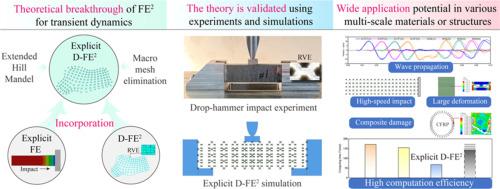用于瞬态多尺度分析的显式 D-FE2 方法
IF 7.1
1区 工程技术
Q1 ENGINEERING, MECHANICAL
International Journal of Mechanical Sciences
Pub Date : 2024-11-09
DOI:10.1016/j.ijmecsci.2024.109808
引用次数: 0
摘要
显式 FE(有限元)方法在各种模拟中具有明显优势,包括非线性瞬态动力学、屈曲引起的大变形以及材料或结构的损伤演化。然而,传统的计算均质化技术,如 FE2 和直接 FE2(D-FE2)方法,由于其数值实现的隐式框架,尚未与显式算法集成,因此无法广泛应用于多尺度材料和结构中瞬态动力学问题的多层次并发建模。本研究在 Tan[1] 提出的 D-FE2 方法基础上,将显式积分算法融入微尺度 RVE 数值计算中,提出了显式 D-FE2 方法。为此,推导了考虑宏观和微观尺度之间动能和内能守恒的扩展希尔-曼德尔原理,并使用显式 FE 方法对传统 D-FE2 方法进行了修改。利用一系列实验和数值实例验证了所提出的显式 D-FE2 方法,这些实例包括落锤对多尺度蜂窝的冲击、多孔材料中的应力波传播、多稳定超材料的压缩屈曲、纤维增强复合材料的损伤和失效等。研究验证了所提出的显式 D-FE2 方法在多尺度材料和结构的瞬态动力学分析中的可行性和高效性,这可能是冲击动力学领域的一个新的研究方向。本文章由计算机程序翻译,如有差异,请以英文原文为准。

An explicit D-FE2 method for transient multiscale analysis
Explicit FE (Finite Element) method offers distinct advantages for a variety of simulations, including nonlinear transient dynamics, large deformation due to buckling, and damage evolution in materials or structures. However, conventional computational homogenization techniques, such as the FE2 and direct FE2 (D-FE2) methods, have not yet been integrated with an explicit algorithm because of the implicit framework in their numerical implementation, and thus cannot be widely applied to concurrent multi-level modeling of transient dynamic issues in multiscale materials and structures. In this study, an explicit D-FE2 method was proposed by incorporating explicit integration algorithms into the numerical calculation of microscale RVEs based on the D-FE2 method proposed by Tan [1]. To facilitate this, an extended Hill–Mandel principle which considers the conservation of both kinetic and internal energies between macro- and micro-scales was derived, and the conventional D-FE2 method was modified using the explicit FE method. The proposed explicit D-FE2 method was validated using a series of experiments and numerical examples including drop-hammer impact on multiscale honeycomb, stress wave propagation in porous materials, compressive buckling of multi-stable metamaterials, damage and failure of fiber-reinforced composites, etc. It was validated that the proposed explicit D-FE2 method is feasible and efficient for transient dynamic analysis of multiscale materials and structures, which might be a new avenue of research in the field of impact dynamics.
求助全文
通过发布文献求助,成功后即可免费获取论文全文。
去求助
来源期刊

International Journal of Mechanical Sciences
工程技术-工程:机械
CiteScore
12.80
自引率
17.80%
发文量
769
审稿时长
19 days
期刊介绍:
The International Journal of Mechanical Sciences (IJMS) serves as a global platform for the publication and dissemination of original research that contributes to a deeper scientific understanding of the fundamental disciplines within mechanical, civil, and material engineering.
The primary focus of IJMS is to showcase innovative and ground-breaking work that utilizes analytical and computational modeling techniques, such as Finite Element Method (FEM), Boundary Element Method (BEM), and mesh-free methods, among others. These modeling methods are applied to diverse fields including rigid-body mechanics (e.g., dynamics, vibration, stability), structural mechanics, metal forming, advanced materials (e.g., metals, composites, cellular, smart) behavior and applications, impact mechanics, strain localization, and other nonlinear effects (e.g., large deflections, plasticity, fracture).
Additionally, IJMS covers the realms of fluid mechanics (both external and internal flows), tribology, thermodynamics, and materials processing. These subjects collectively form the core of the journal's content.
In summary, IJMS provides a prestigious platform for researchers to present their original contributions, shedding light on analytical and computational modeling methods in various areas of mechanical engineering, as well as exploring the behavior and application of advanced materials, fluid mechanics, thermodynamics, and materials processing.
 求助内容:
求助内容: 应助结果提醒方式:
应助结果提醒方式:


